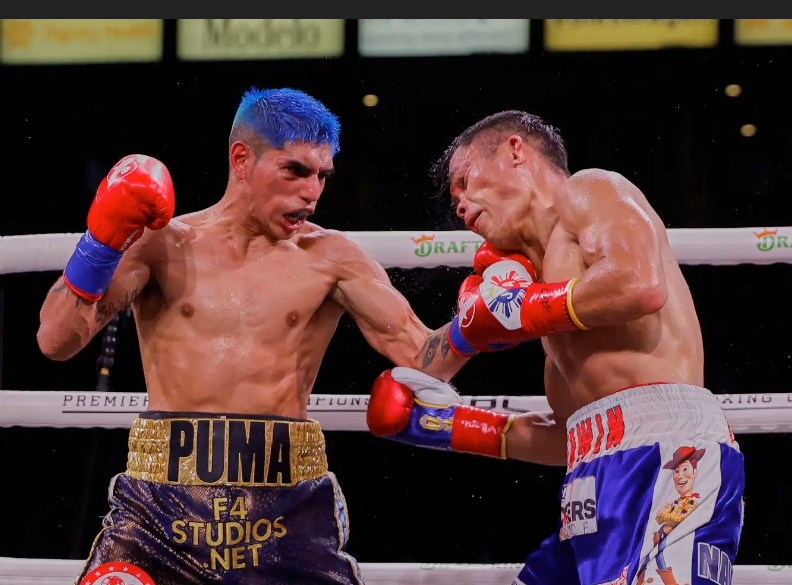Featured Articles
Fernando Martínez, an Oasis in Argentine Boxing

The triumph of Fernando Martínez last Saturday, October 8th, in the rematch against the veteran former world champion Jerwin Ancajas, gave a sigh of relief to the authorities and boxing enthusiasts of Argentina, as there has been a lack of Argentine title-holders.
With a very aggressive performance beginning in the third round, Fernando “El Puma” Martínez (15-0-0, 8 KOs) managed to retain the IBF super flyweight crown which he had snatched from the Tagalog southpaw, also by unanimous decision, on February 26th at the Cosmopolitan Hotel in Las Vegas.
Now Martínez, 31 years old and a native of the city of Avellaneda in Greater Buenos Aires, is the fortieth and only current champion of that country, which has had a rich history in the discipline at the international level since 1954 when Pascual “El León Mendocino” Pérez won the WBA flyweight belt after beating Japanese Yoshio Shirai by points in 15 rounds. Shirai had successfully held the crown for nine defenses.
The list of 40 professional Argentine boxing champions includes, among others, the late Carlos “Escopeta” Monzón, who snatched the middleweight title from Italian Nino Benvenuti in 1970 and later defended it 14 times.
Equally outstanding is the trajectory of Omar “El Huracán” Nárvaez, a WBO flyweight champion who held the title through 16 fights between 2002 and 2009. He also successfully defended the WBO super flyweight title 11 times between 2010 and 2014.
Martínez’s first success against Ancajas was surprising. So much so that the odds were tilted 5-1 for the victory of the Asian, who was defending the world belt for the tenth occasion since 2016 when he obtained it by defeating the Puerto Rican twin McJoe Arroyo (18-4-0, 8 KOs) in Philippine territory.
But after that convincing “performance” by Martinez, the landscape changed drastically for the second matchup. This time the South American started as a 3-1 favorite and again came out with his arm raised at the Dignity Health Sports Park in California, backing up the predictions.
The votes of the three officials reflected what happened in the ring: judges Tiffany Clinton and Zachary Young delivered scorecards of 118-110, while Ellis Johnson awarded 11 rounds to the winner and only one to the loser (119-109).
“This was about validating the first fight,” said Martinez, who did all the previous preparation on Argentine soil under the direction of Rodrigo Calabrese. “I trained very hard for this fight. I have a lot of people to thank, but most importantly this is for my dad up in heaven.”
And still smiling in the ring, in the company of his promoter, the former star Marcos “El Chino” Maidana and several members of the coaching staff, Martínez launched the logical challenge to the great figures of 115 pounds.
It is worth remembering that the current promoter Maidana is also a member of the select group of Argentine champions. He won the 140-pound world title by defeating Russian Petr Petrov by knockout in the fourth round in September 2011. And three years later, in December 2013, he won the WBA welterweight title, unanimously defeating the American Adrien “The Problem” Broner, in San Antonio, Texas.
When referring to the victory against Ancajas, Martínez stated: “It’s definitely harder to maintain the hunger and retain the title, but now we’re going after ‘Chocolatito’ Gonzalez and everyone else in the division who’s in my way.”
That path to the best of the 115-pounders that Martínez intends to travel is full of thorns, because in addition to González, it is made up of the Mexicans Juan Francisco “El Gallo” Estrada (42-3-0, 28 KOs) and Jesse “Bam” Rodríguez (17-0-0, 11 KOs), franchise champion and “regular” champion of the WBC, respectively.
Also holding championship belts in the super flyweight category are the American Joshua “El Professor” Franco (18-1-2, 8 KOs) and the Japanese Kazuto Ioka (29-2-0, 15 KOs), owners of the WBA and the WBO belts, respectively.
“My record shows that I’m a champion but it doesn’t show the intensity that I have in my fights,” said Martinez. “Now I can buy the house that my mother needs.”
Photo credit: Esther Lin / SHOWTIME
To comment on this story in the Fight Forum CLICK HERE
Article submitted by Jorge Juan Alvarez in Spanish.
Please note if there are any errors in translation, they were completely unintentional.
-

 Featured Articles4 weeks ago
Featured Articles4 weeks agoAvila Perspective, Chap. 330: Matchroom in New York plus the Latest on Canelo-Crawford
-

 Featured Articles3 weeks ago
Featured Articles3 weeks agoVito Mielnicki Jr Whitewashes Kamil Gardzielik Before the Home Folks in Newark
-

 Featured Articles21 hours ago
Featured Articles21 hours agoResults and Recaps from New York Where Taylor Edged Serrano Once Again
-

 Featured Articles4 weeks ago
Featured Articles4 weeks agoCatching Up with Clay Moyle Who Talks About His Massive Collection of Boxing Books
-

 Featured Articles5 days ago
Featured Articles5 days agoFrom a Sympathetic Figure to a Pariah: The Travails of Julio Cesar Chavez Jr
-

 Featured Articles3 weeks ago
Featured Articles3 weeks agoMore Medals for Hawaii’s Patricio Family at the USA Boxing Summer Festival
-

 Featured Articles1 week ago
Featured Articles1 week agoCatterall vs Eubank Ends Prematurely; Catterall Wins a Technical Decision
-

 Featured Articles4 weeks ago
Featured Articles4 weeks agoRichardson Hitchins Batters and Stops George Kambosos at Madison Square Garden




















